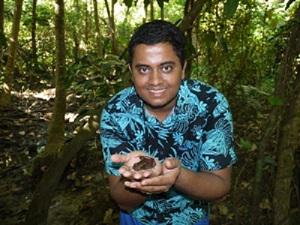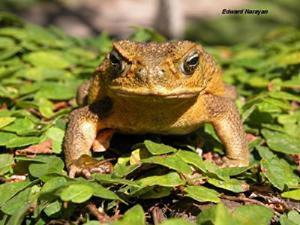Edward Narayan
Other projects
15 Apr 2008
Monitoring the Reproductive Success of Endangered Fijian Ground Frog on Viwa Islands
16 Nov 2009
Annual Assessment of Chytrid Fungus Prevalence amongst Endangered Native Fijian Ground Frog Populations on Viwa – Fiji Islands
This project has two research aims, i) undertaking scientific research to eliminate cane toads from breeding habitats of the endangered Fijian ground frog (Platymantis vitiana) [FGF] on Viwa Island in order to enhance the reproductive output of the FGF; ii) engaging Viwa community in developing a management action plan utilizing cultural protocols and norms. Through these two activities we intend to strengthen protection and growth of Fijian ground frog population on Viwa Island.

Dr. Narayan holding a Fijian ground frog on Viwa Island.
The issue of cane toad control, aimed to be addressed in this proposal, is a very hot issue both within local and international scientific and management societies. The listing of FGF as an IUCN endangered species and in the Edge (the world’s most extraordinary species) list increases the urgency for its in-situ conservation and management.

Non-native cane toad (Rhinella marina) on Viwa Island.
Cane toads (Rhinella marina) have been driving native fauna, especially amphibians, reptiles and birds, towards extinction in neighbouring Pacific Island countries including Australia, New Guinea and Hawaii by its predatory and poisonous nature (if eaten by a native species). Through my 1st RSG grant, it was clearly demonstrated that toads are endangering the FGF through competition for habitat space, food and also through predation of froglets and sub-adults.
The population of cane toads on Viwa Island is nearly 4 times higher than the FGF population on Viwa Island. Thus considering the small size of Viwa Island and the high abundance of toads on Viwa, the aim of this project is to undertake toad control (exclusion) trials within targeted FGF breeding sites.
Thus this project aims to enhance the reproductive output and population growth of the FGF on Viwa Island.